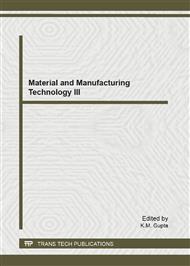p.115
p.119
p.123
p.128
p.133
p.138
p.143
p.147
p.153
Preparation and Microwave Absorbing Properties of Iron Oxides/Carbon Nanotubes Compounds
Abstract:
A Series of iron oxides/CNTs compounds were prepared using a method of impregnation with iron nitrate solution and followed thermal decomposition. The compounds were characterized by the means of scanning electronic microscope, X-ray diffraction and thermogravimetic analysis. The dielectric and microwave-absorbing properties of EP composites containing the different compounds were further measured in a specific frequency range. The results show that: CNTs show reduction at a high temperature, and can make products of the thermal decomposition of iron nitrate produce iron oxide nanoparticles with different valence states at different temperatures. With increasing decomposition temperature, the iron oxides in CNTs composites in turn are Fe2O3, Fe3O4, FeO and Fe. Compared with pure CNTs, these iron oxides/CNTs composites have better microwave absorbing properties in the wavebands of 7.5GHz ~ 15GHz and 26.5GHz ~ 40GHz. Among those iron oxides /CNTs compounds, Fe3O4/CNTs compound has the best microwave absorbing property.
Info:
Periodical:
Pages:
133-137
Citation:
Online since:
July 2012
Authors:
Price:
Сopyright:
© 2012 Trans Tech Publications Ltd. All Rights Reserved
Share:
Citation:


